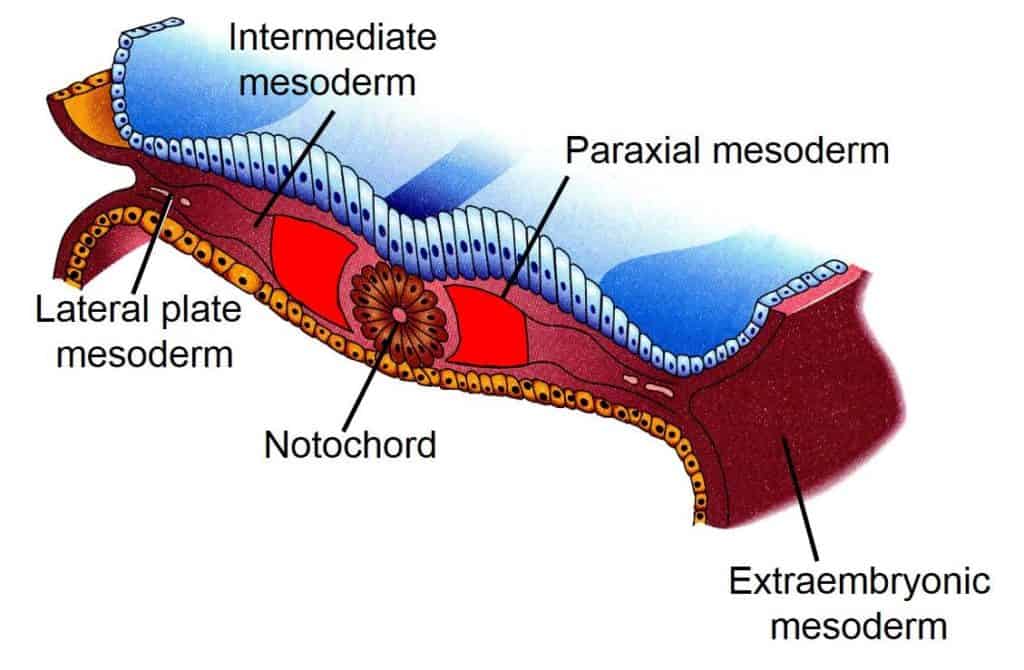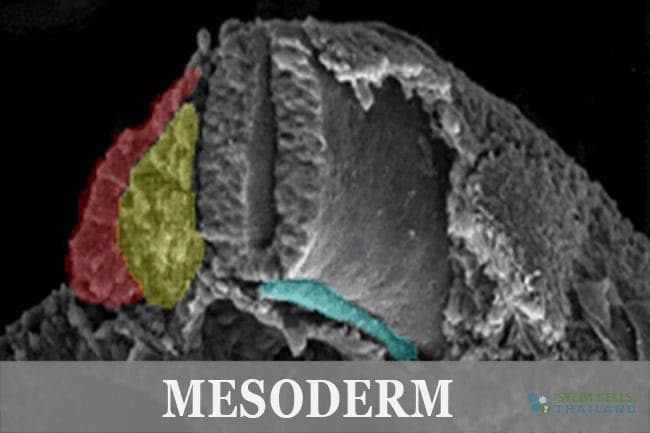Mesoderm is the The middle part of the three germ layers and a derivative of a blastocyst inner cell mass. The mesodermal layer is composed of cells that have the ability to differentiate into muscle and bone cells, as well as kidney cells ,ligaments and connective tissues.[1]
Mesoderm specifically gives rise to the following structures and tissues:
- Musculoskeletal System: Includes muscles (both smooth and striated), cartilage, bones, and connective tissue.
- Circulatory and Lymphatic Systems: Comprises the heart, blood vessels, and blood cells, as well as the lymphatic vessels and structures.
- Urogenital System: Gives rise to the kidneys, ureters, gonads (testes in males and ovaries in females), and reproductive ducts.
- Dermis of the Skin: The deeper layer of the skin.
- Linings of the Body Cavities: Includes the linings of the pleural, pericardial, and peritoneal cavities.
- Spleen: An organ involved in filtering blood and serving as a reservoir for red blood cells and immune cells.
- Adrenal Cortex: The outer layer of the adrenal glands, responsible for producing hormones like cortisol and aldosterone.
During embryonic development, the mesoderm originates from the epiblast. Through a process called gastrulation, cells migrate inwards to form this middle germ layer. As development progresses, the mesoderm further differentiates and specializes to form the above-mentioned structures and tissues.
The proper formation and differentiation of the mesoderm are crucial for the development of a healthy embryo. Any disruptions or abnormalities in this process can lead to congenital malformations or developmental disorders.
For humans, the mesoderm is among the 3 primary germ cell layers. The other two germ layers are endoderm and the ectoderm. In the early stages of an embryo the mesoderm area is the central layer.The Mesoderm layer forms during gastrulation and lies between the ectoderm and the endoderm.[2]

It leads to development of some glands and also helps give rise to several other vital structures and tissues including cartilage,bone,connective tissue, muscle, blood for vascular system, reproductive,urinogenital and excretory systems. Stem cells in mesodermal tissues keep the ability to differentiate in varied ways. For instance, Bone marrow stem cells “mesoderm” can become liver cells “endoderm”.[3]
The mesoderm can be identified with 3 germ layers seen in the embryo of all “Bilaterian” creatures. That includes all creatures on Earth with the exception Cnidarians,Placozoans and sponges making them triploblastic. The NODAL indicator helps to mediate the initial formation of the mesoderm layer.
Published Clinical Citations
[1] ^ Phermthai, Tatsanee, Singpetch Suksompong, Nednapis Tirawanchai, Surapol Issaragrisil, Suphakde Julavijitphong, Suparat Wichitwiengrat, Decha Silpsorn, and Puttachart Pokathikorn. 2013. Epigenetic analysis and suitability of amniotic fluid stem cells for research and therapeutic purposes. Stem cells and development, no. 9 (February 12). doi:10.1089/scd.2012.0371. https://www.ncbi.nlm.nih.gov/pubmed/23249260
[2] ^ Noisa, Parinya, and Rangsun Parnpai. 2011. Technical challenges in the derivation of human pluripotent cells. Stem cells international (June 19). doi:10.4061/2011/907961. https://www.ncbi.nlm.nih.gov/pubmed/21776284
[3] ^ Moroz, Leonid L, Kevin M Kocot, Mathew R Citarella, Sohn Dosung, Tigran P Norekian, Inna S Povolotskaya, Anastasia P Grigorenko, et al. 2014. The ctenophore genome and the evolutionary origins of neural systems. Nature, no. 7503 (May 21). doi:10.1038/nature13400. https://www.ncbi.nlm.nih.gov/pubmed/24847885

